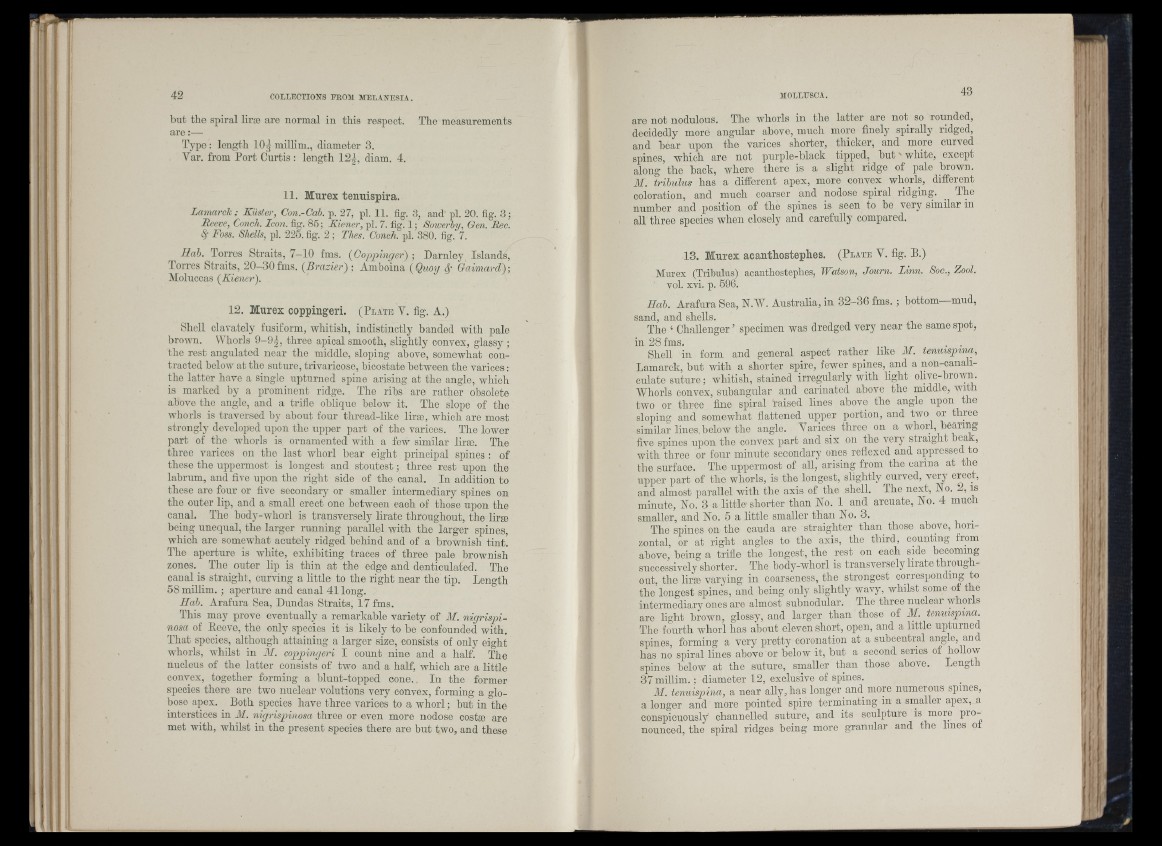
but the spiral lira? are normal in this respect. The measurements
are
Typo: length IO5 millim., diameter .3.
Var. from Port Curtis : length 121, diam. 4.
I‘ I
11. Murex tenuispira.
Lamarck; Küster, Con.-Cab. p. 27, pi. 11. fig. 3, and pi. 20. fig. 3;
Reeve, Conch. Icon. tig. 85; Kiener, pi. 7. tig. 1; Sowerhy, Gen. Rec.
Foss. Shells, pi. 225. fig. 2; Thes. Conch, pi. 380. fig. 7.
Hah. Torres Straits, 7-10 fms. (Coppinger) ; Darnley Islands,
Torres Straits, 20—30fins. (Brazier) : Amboina (Quoy ¡f Gaimarcl);
Moluccas (Kiener).
!
12. Murex coppingeri. (P la te V. fig. A.)
Shell clavately fusiform, whitish, indistinctly banded with pale
brown. Whorls 9-9g, three apical smooth, slightly convex, glassy ;
the rest angulatod near the middle, sloping above, somewhat contracted
below at the suture, trivaricose, bicostate between the varices :
the latter have a single upturned spine arising at the angle, which
is marked by a prominent ridge. The ribs are rather obsolete
above the angle, and a trifle oblique below it. The slope of the
whorls is traversed by about four thread-like liræ, which are most
strongly developed upon the upper part of the varices. The lower
part of the whorls is ornamented with a few similar liræ. The
three varices on the last whorl bear eight principal spines : of
these the uppermost is longest and stoutest ; three rest \ipon the
labrnm, and five upon the right side of the canal. In addition to
these are four or fivo secondary or smaller intermediary spines on
the outer lip, and a small erect one between each of those upon the
canal. The body-whorl is transversely lirate throughout, the liræ
being unequal, the larger running parallel with the larger spines,
which are somcAvhat acutely ridged behind and of a brownish tint.
The aperture is white, exhibiting traces of three pale brownish
zones. The outer lip is thin a t the edge and denticulated. The
caual is straight, curving a little to the right near the tip. Length
58 millim. ; aperture and canal 41 long.
Hah. Arafura Sea, Dundas Straits, 17 fms.
This may prove eventually a remarkable variety of ilf. nigrispi-
nosa of Eeeve, the only species it is likely to be confounded with.
That species, although attaining a larger size, consists of only eight
whorls, Avhilst in Ai. coppingeri I count nine and a half. The
nucleus of the latter consists of two and a half, which are a little
convex, together forming a blunt-topped cone. In the former
species there are two nuclear volutions very convex, forming a globose
apex. Both species have three varices to a whorl ; but in the
interstices in AI. nigrispinosa three or even more nodose costæ are
met with, whilst in the present species there are but two, and these
are not nodulous. The whorls in the latter are not so rounded,
decidedly more angular above, much more finely spirally ridged,
and hear upon the varices shorter, thicker, and more curved
spines, which are not purple-black tipped, b u t ' white, except
along the hack, where there is a slight ridge of pale brown.
JE. trihulus has a different apex, more convex whorls, different
coloration, and much coarser and nodose spiral ridging. The
number and position of the spines is seen to be very similar in
all three species when closely and carefully compared.
13. Murex acanthostephes. (Plate V. fig. B.)
Murex (Trihulus) acanthostephes, Watson, Journ. Linn. Soc., Zool.
vol. xvi. p. 596.
Hah. Arafura Sea, N.W. Australia, in 32-36 fm s .; bottom—mud,
sand, and shells.
The ‘ Challenger ’ specimen was dredged very near the same spot,
in 28 fms. . . .
Shell in form and general aspect rather like AI. tenmspina,
Lamarck, but with a shorter spire, fewer spines, and a non-canali-
culate suture; whitish, stained irregularly with light ohve-broAvn.
Whorls convex, snhangnlar and carinatcd above the middle, with
two or three fine spiral raised lines above the angle upon the
sloping and somewhat flattened upper portion, and two or three
similar lines, below the angle. Varices three on a whorl, hearing
five spines upon the convex part and six on the very straight beak,
Avith three or four minute secondary ones reflexcd and appressed to
the surface. The uppermost of all, arising from the carina a t the
upper part of the whorls, is the longest, slightly curved, very erect,
and almost parallel witli the axis of the shell. The next, No. 2, ib
minute. No. 3 a little shorter than No. 1 and arcuate, No. 4 much
smaller, and No. 5 a little smaller than No. 3. _
The spines on the cauda are straighter than_ those above, horizontal,
or at right angles to the axis, the third, counting from
above, being a trifle the longest, the rest on each side becoming
successively shorter. The body-whorl is transversely lirate throughout,
the lirfB varying in coarseness, the strongest corresponding to
the longest spines, and being only slightly waA^y, whilst some of the
intermediary ones are almost snhnodular. The three nuclear yhorls
are light brown, glossy, and larger than those of AI. tenuispina.
The fourth whorl has about eleven short, open, and a little upturned
spines, forming a very 7>retty coronation at a subcentral angle, and
has no spiral lines above or below it, but a second series of holloAV
spines below at the suture, smaller than those above. Length
37 millim.; diameter 12, exclusive of spines.
AI. tenuispina, a near ally, has longer and more numerous spines,
a longer and more pointed spire terminating in a smaller apex, a
conspicuously channelled suture, and its sculpture is more pronounced,
the spiral ridges being more granular and the lines of
it i '